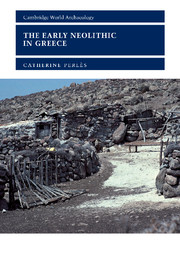Book contents
- Frontmatter
- Contents
- List of figures
- List of tables
- Acknowledgements
- Introduction
- 1 The land and its resources: the geographic context
- 2 The Mesolithic background
- 3 The introduction of farming: local processes, diffusion or colonization?
- 4 Foreign colonists: where from?
- 5 The earliest Neolithic deposits: ‘aceramic’, ‘pre-pottery’ or ‘ceramic’?
- 6 The spread of the Early Neolithic in Greece: chronological and geographical aspects
- 7 A case study in Early Neolithic settlement patterns: eastern Thessaly
- 8 Early Neolithic subsistence economy: the domestic and the wild
- 9 The Early Neolithic village
- 10 Craft specialization: the contrasting cases of chipped-stone tools, pottery and ornaments
- 11 A variety of daily crafts
- 12 Ritual interaction? The miniature world of ‘dolls or deities’
- 13 Interacting with the dead: from the disposal of the body to funerary rituals
- 14 Interactions among the living
- Conclusion
- Bibliography
- Index
7 - A case study in Early Neolithic settlement patterns: eastern Thessaly
Published online by Cambridge University Press: 18 December 2009
- Frontmatter
- Contents
- List of figures
- List of tables
- Acknowledgements
- Introduction
- 1 The land and its resources: the geographic context
- 2 The Mesolithic background
- 3 The introduction of farming: local processes, diffusion or colonization?
- 4 Foreign colonists: where from?
- 5 The earliest Neolithic deposits: ‘aceramic’, ‘pre-pottery’ or ‘ceramic’?
- 6 The spread of the Early Neolithic in Greece: chronological and geographical aspects
- 7 A case study in Early Neolithic settlement patterns: eastern Thessaly
- 8 Early Neolithic subsistence economy: the domestic and the wild
- 9 The Early Neolithic village
- 10 Craft specialization: the contrasting cases of chipped-stone tools, pottery and ornaments
- 11 A variety of daily crafts
- 12 Ritual interaction? The miniature world of ‘dolls or deities’
- 13 Interacting with the dead: from the disposal of the body to funerary rituals
- 14 Interactions among the living
- Conclusion
- Bibliography
- Index
Summary
The exceptional density of long-term Neolithic settlements in Thessaly was recognized from the beginning of the century. In the decades that followed, successive surveys gradually increased the number of sites identified, bringing the total to more than 300. In 1984, Halstead exploited an already impressive corpus and offered the first thorough analysis of settlement patterns in Thessaly (Halstead 1984). Although the details of his analyses have remained unpublished, the main diachronic and synchronic conclusions can be found in several papers (e.g., Halstead 1977, 1981a, 1989a, 1989b, 1994, 1995). Not much can presently be added to his analyses of western Thessaly, the Karditsa plain. In the meantime, however, Gallis had resumed surveys in eastern Thessaly with his collaborators, leading to the publication of a systematic ‘Atlas of prehistoric settlements in eastern Thessaly’ (the ATAE). This included several newly discovered sites and refined chronological attributions, as well as various statistics on the chronological distribution of sites, the duration of their occupation, their size, etc. (Gallis 1992).
Relying on Gallis' Atlas and recent geomorphological fieldwork (van Andel et al. 1995), van Andel and Runnels published another study that concentrated on the palaeo flood-plains of the Larissa basin. Though more restricted in scope than the previous analyses, its conclusions differed and were the basis of important theoretical developments on the causes and dynamics of the Neolithic expansion (van Andel and Runnels 1995).
- Type
- Chapter
- Information
- The Early Neolithic in GreeceThe First Farming Communities in Europe, pp. 121 - 151Publisher: Cambridge University PressPrint publication year: 2001



